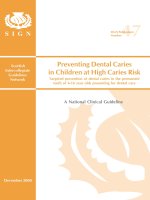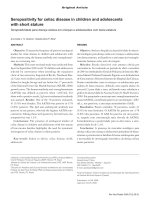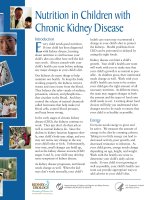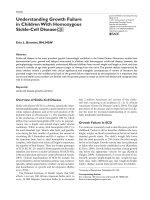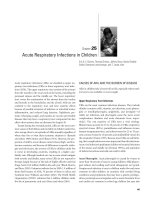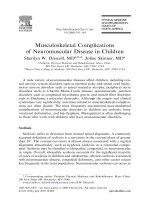8 drug allergy in children
Bạn đang xem bản rút gọn của tài liệu. Xem và tải ngay bản đầy đủ của tài liệu tại đây (11.46 MB, 46 trang )
WORKSHOP in HANOI on April 29, 2017
Chang-Keun Kim, M.D., Ph.D.
Asthma & Allergy Center
Inje University-Sanggye Paik Hospital
Seoul, Korea
• Total reported: about
230,000 Events in 2016
• Mild 68.3%,
• Moderate 26.8%
• Severe 4.9%
Year
Source: open KFDA Reports. 2016
Top 5 list in Korea
• Anti-inflammatory Analgesics - 13.6%, most common
• Anticancer drug - 9.3%
• Antibiotics - 8.1%
• X-ray contrast media - 8.0%
• Synthetic drug - 7.8%
Source: open KFDA Reports. 2016
Usually experience some of the following symptoms
• Skin rash
• Hives
• Itchy skin
• Difficulty breathing
• Light headedness, dizziness, loss of consciousness
• Chief complaint : worsening dyspnea after
corticosteroids treatment at ER
• Age/sex : 9 years old boy
• Family History : Mother-B-asthma
• PHx : B-asthma
• Five to 10 minutes after the IV hydrocortisone infusion
he developed worsening dyspnea and wheezing
• 30 minutes later, he immediately presented with nausea,
dizziness, weakness
• At ICU admission, the patient was comatose, with dyspnea,
generalized edema, arterial hypotension, and bradycardia
After tracheal intubation, cardiopulmonary resuscitation, and
infusions of dopamine and norepinephrine, and he was placed
on mechanical ventilation due to respiratory failure.
Immediate hypersensitivity to corticosteroids:
a case series in New Zeland
• From 28 reactions (in 23 patients), the most common route of
administration was intra-articular (13), followed by oral (7),
intravenous (3) and other (5).
• Skin tests were positive in 8/23 patients,
• 7/8 of these patients had a history of corticosteroid-associated
anaphylaxis.
• Skin tests were positive at either the skin prick test or intradermal
stages.
Baker at al. Clin Exp Allergy. 2015
A patient Case (admission : 2017. April 15)
• Chief complaint : Skin rash, Difficult breathing dizziness after Amoxicillin
treatment
• Age/Sex : 4 yrs, Boy
• FHx : Mother (34 yrs), Hx of penicillin allergy
Grandmother ( 62 yrs), Hx of penicillin allergy
• PHx : Milk allergy
On admission
After 6 days
• The antibiotics most likely to cause an allergic reaction are penicillins and
cephalosporins.
• Mild symptoms include red, itchy, flaky, or swollen skin.
• Severe symptoms include skin that blisters or peels, vision problems, and
severe swelling or itching. Severe reactions include conditions such as toxic
epidermal necrolysis (TEN).
• Anaphylaxis symptoms include throat tightness, trouble breathing, tingling,
dizziness, and wheezing.
• Anaphylaxis is a sudden, life-threatening reaction
** Anaphylaxis may occur if you exercise after exposure to a trigger,
such as after taking an antibiotic
• Other allergies, such as to cats
• A family history of antibiotic allergies
• Frequent use of antibiotics
• A long-term illness that makes your immune
system more sensitive
• Specific
• Sensitive
• Simple to perform
• Rapid (result in 15-20 min)
• Educational for patient
• More sensitive than SPT
• May Induce false positive reactions
• May induce systemic reactions
• Sould be done only if skin prick test is
negative and allergen is highly suspect
• Penicilline is only drug with well-validated outcomes
• There are no validated diagnostic tests for evaluation of IgEmediated allergy to non-penicillin antibiotics
• A negative skin test results does not rule out the possibility
of an immediate type allergy
Empedrad R et al. J Allergy Clin Immunology 2003
• Commercially available
– Phadia CAP®/ImmunoCAP(fluorescent enzyme immunoassay, FEIA)
• Less sensitivity and more expensive compared to skin testing
– Sensitivity for penicillins/amoxicillin from 38-54%
– Specificity for penicillins/amoxicillin from 87-100%
• Results
– Positive ≥ 0.7 kU/L (Class 2)
Nasr et al., J Med Microb Diagn 2016
• Antihistamines: decrease mild symptoms such as itching or a rash
• Epinephrine : to treat severe allergic reactions such as anaphylaxis
• Steroids: reduce inflammation
• Desensitization : gradually exposed to small doses
( if you need to be treated with the antibiotic again)
** Most patients lose their penicillin allergy over time, even patients with a
history of severe reaction such as anaphylaxis
Antipyretics and Drug Allergy
Kim CK et al. Pediatr Int. 2013
• When AE were classified according to severity (grades 1–5;
data not shown), there were no differences in severity
between the three groups
• Of the 159 AE, all but three were grade 1 or 2
• All 159 AE were deemed to be either probably not related
or definitely not related
1st injection
0.1 ml
2nd injection
0.2 ml
3rd injection
0.4 ml
4th injection
0.8 ml
5th injection
0.1 ml
6th injection
0.2 ml
7th injection
0.4 ml
Local reaction
Moderate general
reaction
Severe general
reaction
Rash, Swelling
3-7%
Asthma Sx, AR Sx,
Urticaria, Headache
Anaphylaxis
(<30 min)
Influenza
• Infected 500 million people
• Deaths of 50 to 100 million (3-5% of the world's population)

